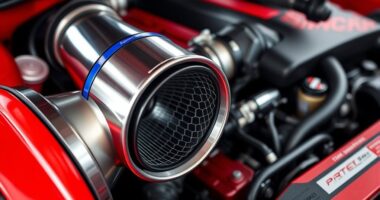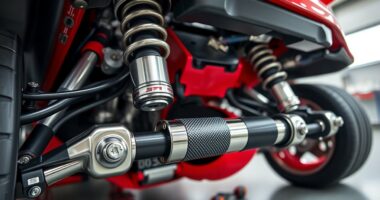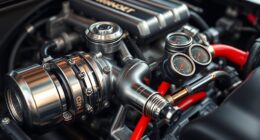Upgrading the differential in your Subaru STI or WRX enhances traction, handling, and durability, especially during aggressive driving. You can choose from clutch-type LSDs, torque-biasing differentials, or electronic units, depending on your driving style and goals. Top brands like Cusco, OS Giken, and Driveshaft Shop offer reliable options. Proper installation and maintenance guarantee long-lasting performance, and selecting the right upgrade can maximize your vehicle’s grip and responsiveness. Keep exploring for detailed tips and options.
Key Takeaways
- Upgrading to aftermarket limited slip differentials (LSDs) like Cusco or OS Giken improves traction and handling during aggressive driving.
- Compatibility depends on model year, differential type (open, VLSD, CLSD, MLSD), and drivetrain specifications.
- Clutch-type LSDs provide quick torque transfer, ideal for performance applications on Subaru STI and WRX models.
- Reinforcing components such as differential covers and braces enhance durability and heat dissipation during high-stress use.
- Proper installation and break-in procedures are essential for optimal performance and long-term reliability of differential upgrades.
Understanding the Different Types of Subie Differentials
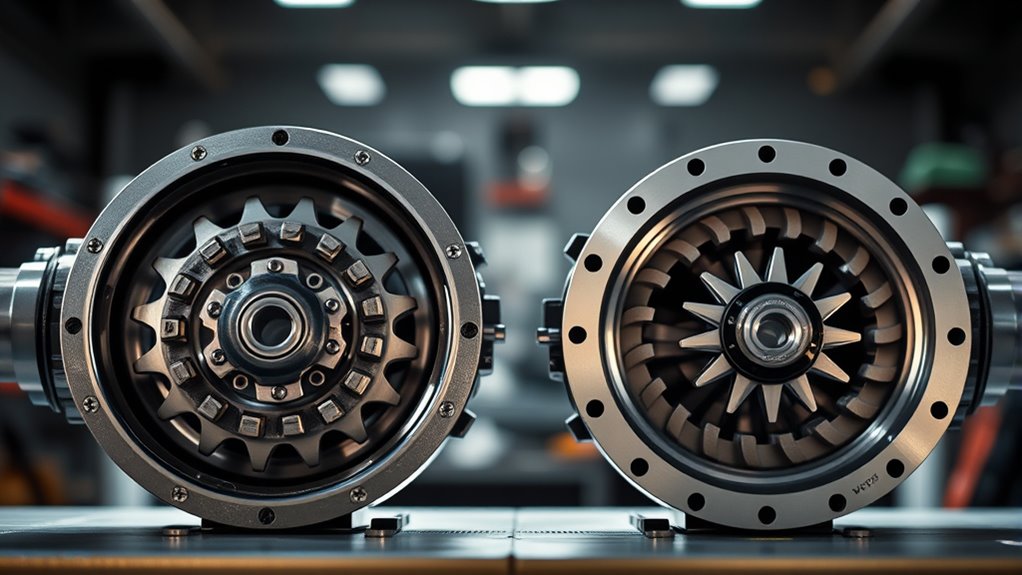
To truly appreciate the performance capabilities of your Subaru, it’s essential to understand the different types of differentials used in these vehicles. Subaru offers several differential types, including open, viscous limited slip (VLSD), center limited slip (CLSD), and mechanical limited slip (MLSD). These components allow for wheel speed differences while maintaining traction, vital for handling and stability. VLSDs, common in older models, use viscous fluid for smooth power transfer but are less effective under high stress. CLSDs, found in higher-performance Subarus, employ mechanical setups to improve grip. MLSDs use clutch packs to provide robust traction and durability, often in performance variants. Understanding these differences helps you grasp how your Subaru manages power distribution and prepares you for potential upgrades.
Benefits of Upgrading Your Subaru’s Differential System

Upgrading your Subaru’s differential system unlocks significant performance benefits that can transform how your car handles and responds on the road or track. You’ll experience improved traction and grip, especially during aggressive cornering, thanks to better torque distribution and tunable locking options. Enhanced drivetrain responsiveness means faster torque transfer and more predictable power delivery, reducing hesitation during rapid maneuvers. Additionally, upgrading your differential boosts cornering performance by reducing understeer, controlling oversteer, and maintaining front and rear grip through synchronized upgrades. These improvements also enhance durability under stress, with heat management and stronger components ensuring longevity during intense driving. Furthermore, celebrity transformations such as improved handling can boost your confidence and driving enjoyment. The integration of advanced differential technologies allows for more precise control and adaptability in various driving conditions, further elevating your vehicle’s capabilities. Finally, customization options allow you to fine-tune preload, bias, and lockup rates, tailoring your differential to your specific driving style and surface conditions. Incorporating proper differential fluid management and choosing high-quality lubricants can further optimize performance and longevity of the system.
Choosing the Right Differential for Your Performance Goals

Choosing the right differential depends heavily on your specific performance goals and driving style. If you want sharp cornering and quick response, clutch-type LSDs excel, providing fast torque transfer in tight turns. For consistent grip in high-power applications, torque biasing differentials distribute torque efficiently without sacrificing handling. Open differentials are suitable for daily driving but lack performance features. Electronic differentials offer customizable torque management through software, ideal for adapting to changing conditions. Hybrid systems combine benefits for a balance of stability and performance. Consider your vehicle’s weight distribution, traction needs, and engine output. Racing or autocross demands high-performance setups, while street driving benefits from a balanced upgrade. Keep in mind *maintenance* and compatibility to ensure your differential upgrade aligns with your driving goals. Additionally, understanding the types of differentials can help you make an informed decision tailored to your driving needs. Incorporating performance upgrades like specialized differentials can significantly enhance your vehicle’s handling capabilities and overall driving experience. Recognizing the importance of dog names can also reflect your vehicle’s personality and your own style. Proper understanding of differential technology is crucial for optimizing your vehicle’s handling and ensuring longevity.
Key Components and Brands for Subaru Differential Upgrades
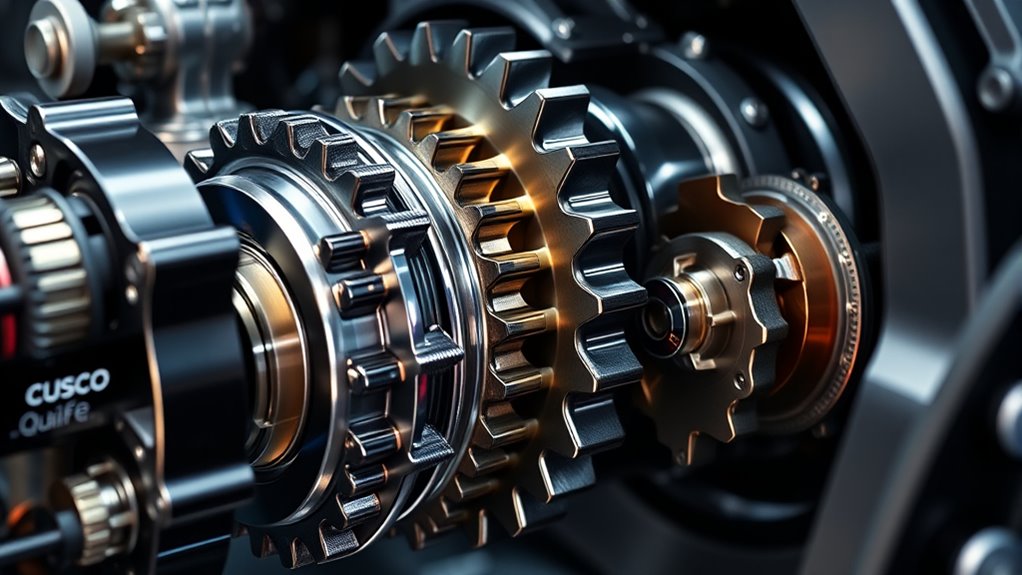
When taking into account key components for Subaru differential upgrades, focusing on the right parts can considerably improve traction and durability. Choosing quality brands ensures reliable performance and longevity in demanding conditions.
Focusing on quality parts for Subaru differential upgrades boosts traction, durability, and long-term reliability.
Here are three top components to consider:
- Limited slip differentials (LSDs) – Clutch-type and torsen-style LSDs optimize torque transfer for better grip. Differential design plays a crucial role in how effectively power is distributed to the wheels. Selecting the appropriate differential type can significantly impact vehicle handling, especially in high-performance applications. Additionally, understanding the installation process ensures that these components function correctly and safely. Utilizing advanced manufacturing techniques can further enhance the durability and precision of these components.
- Differential covers – Aftermarket covers improve heat dissipation and reinforce structural integrity. Ensuring compatibility with your vehicle’s specifications is essential for optimal performance.
- Ring and pinion sets – High-strength gears handle increased power, reducing wear and noise. Proper installation and gear ratio selection can significantly impact handling characteristics.
Leading brands like Cusco, OS Giken, and Driveshaft Shop offer durable, high-performance options. Selecting the right components from reputable brands helps you achieve your desired handling and reliability in your Subaru. AI security advances underscore the importance of choosing reliable, high-quality components to ensure optimal performance and safety.
Compatibility and Installation Considerations for STI and WRX Models

Understanding the compatibility and installation considerations for STI and WRX models is essential to make sure your differential upgrade fits and functions correctly. First, check your model year and generation, since 2007+ STI models use torque-biasing differentials that may differ from earlier versions. WRX models typically lack advanced differentials, requiring aftermarket LSDs for comparable performance. Ensure gear ratios match your existing drivetrain setup to prevent mechanical issues. Rear differential types differ: STI uses R180, WRX uses R160, affecting axle compatibility. Additionally, consider the drivetrain architecture—STI’s DCCD system and electronic components may need wiring or sensor adjustments. Always verify mounting points, driveshaft compatibility, and sensor integration to ensure a smooth installation and optimal performance. Being aware of differential types and their specifications helps prevent incompatibility issues during upgrades. Proper understanding of drivetrain architecture can also facilitate troubleshooting during installation. Moreover, consulting manufacturer specifications can help identify compatibility issues early in the upgrade process to avoid costly mistakes. Additionally, reviewing upgraded components compatibility can ensure the longevity and reliability of your modifications.
Maintenance and Break-In Tips for Differential Upgrades
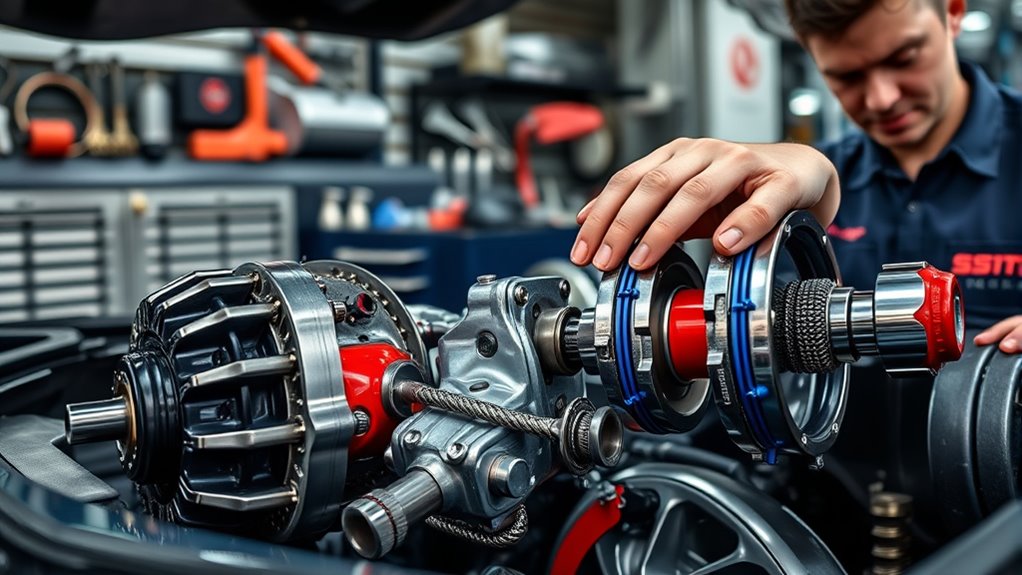
Proper maintenance and careful break-in procedures are crucial to ensuring your upgraded differential performs reliably and lasts longer. During the break-in, drive gently to allow new components to seat properly, and tighten all bolts to the specified torque. Ensure that you follow specific break-in procedures to optimize performance and longevity. A thorough inspection after initial use can help identify early signs of wear or potential issues. Avoid extreme temperatures, heavy loads, and aggressive driving to prevent damage. After installation, regularly inspect the differential fluid for signs of contamination or degradation, and ensure fluid levels are correct. Additionally, consult reputable sources to verify that your installation complies with recommended maintenance practices, including monitoring differential fluid quality and levels.
Enhancing Handling and Traction With Differential Modifications
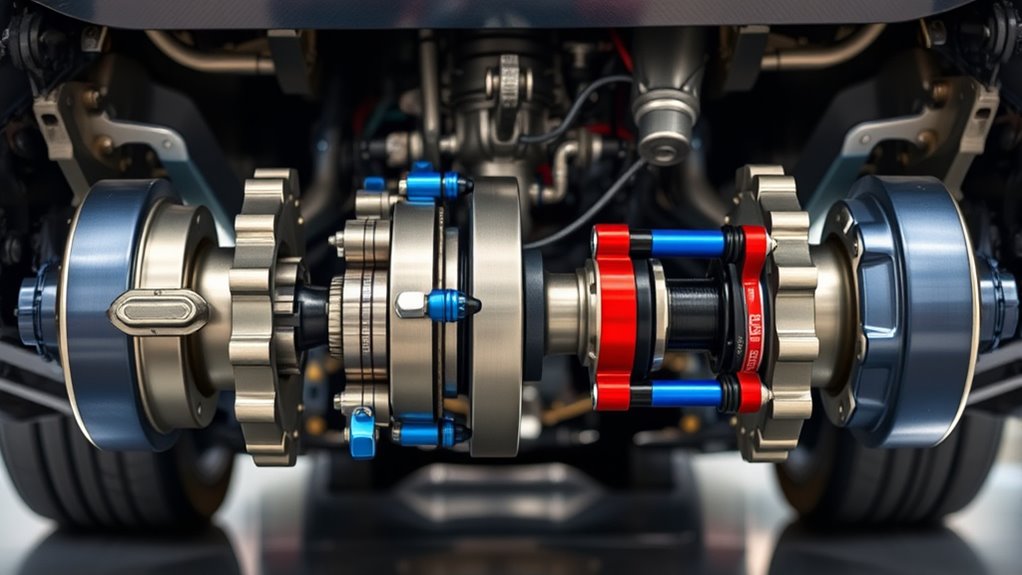
Enhancing handling and traction in your Subaru requires more than just good tires; upgrading the differential plays a crucial role in optimizing power distribution. Torque biasing differentials, like those in the STI, direct more torque to the wheel with better grip, improving stability and cornering. Limited Slip Differentials (LSDs) prevent wheel spin during acceleration, boosting launch control and high-speed stability. Upgrading to aftermarket LSDs from brands like Cusco or OS Giken enhances durability and responsiveness. For the WRX, which lacks advanced factory differentials, aftermarket upgrades considerably improve handling, traction, and acceleration. Reinforcing accessories like diff braces also help maintain stability during aggressive driving. Additionally, understanding the key traits of successful QA engineers can help ensure quality improvements in modifications and upgrades. Moreover, selecting the appropriate differential type based on your driving style can significantly impact overall vehicle performance. Implementing proper maintenance practices for your differentials ensures long-term reliability and optimal performance. Overall, differential modifications give you better grip, more precise cornering, and improved control, transforming your driving experience on both street and track.
Frequently Asked Questions
Can I Upgrade My WRX Differential to an STI R180?
Yes, you can upgrade your WRX differential to an STI R180, but it’s not a straightforward swap. You’ll need to modify the input flange, verify compatibility with your transmission, and match axle splines. Upgrading also involves replacing axles and possibly adjusting mounts. It’s recommended to have a professional handle the installation, as the process requires precision and custom parts to ensure proper fit and performance.
Are Aftermarket LSDS Compatible With OEM Traction Control Systems?
You wonder if aftermarket LSDs can work seamlessly with your OEM traction control system. When you install a Torsen-style helical LSD, it typically integrates smoothly, thanks to passive torque biasing. Clutch-type LSDs might need TC recalibration or adjustments, especially if they lock up aggressively. Two-way LSDs could trigger TC more often, affecting your driving experience. By choosing gear-driven or compatible clutch units, you guarantee reliable performance without compromising your vehicle’s traction control.
How Does a Clutch-Type LSD Differ From a Helical LSD in Daily Driving?
In daily driving, a clutch-type LSD can feel a bit jerky during low-speed maneuvers like parking, due to clutch engagement. It provides strong traction during spirited driving but may produce noise and require regular maintenance like clutch replacements. A helical LSD offers smoother, quieter operation, with seamless torque transfer during cornering, making it more comfortable and reliable for everyday use. It’s low-maintenance, durable, and maintains consistent performance in various conditions.
What Are the Signs of Differential Wear or Failure?
You might think differential issues only appear during extreme driving, but signs show up in daily use too. Listen for whining or clunking noises when turning or accelerating, which indicate worn gears or loose components. Check for uneven tire wear, fluid leaks, or vibrations at speed. If your steering pulls or there’s a grinding sound, these are clear signs of differential wear or failure that need attention before major damage occurs.
Is Professional Tuning Necessary After Installing a New Differential?
After installing a new differential, professional tuning isn’t always mandatory, but it’s highly recommended. You’ll want to guarantee proper integration with your vehicle’s electronic systems, especially if you have features like the DCCD in your STI. Tuning helps optimize handling, torque distribution, and overall performance. Skipping this step could lead to uneven wear, reduced safety, or subpar handling, so consulting an expert ensures your upgrade works seamlessly and safely.
Conclusion
Upgrading your Subaru’s differential is like tuning a finely crafted engine—small tweaks can release big gains. I remember installing a limited-slip diff on my WRX, and suddenly, every twist felt more connected and confident. Just as a well-tuned instrument produces clear music, a properly upgraded differential transforms your driving experience with improved traction and handling. So, choose wisely, install carefully, and enjoy the thrill of a more responsive, exhilarating ride.


